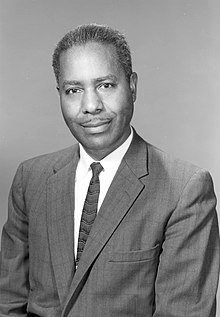Walter McAfee
Walter McAfee | |
|---|---|
 Walter S. McAfee during his time serving as a scientist for the U.S. Army Communication-Electronics Command. | |
| Born | September 2, 1914 Ore City, Texas, US |
| Died | February 18, 1995 (aged 80) South Belmar, New Jersey, US |
| Nationality | American |
| Alma mater | Cornell University Wiley College |
| Known for | Project Diana |
| Scientific career | |
| Fields | Astronomy |
| Doctoral advisor | Hans Bethe |
Walter Samuel McAfee (September 2, 1914 – February 18, 1995) was an American scientist and astronomer, notable for participating in the world's first lunar radar echo experiments with Project Diana.[1]
Personal life[]
McAfee was born in Ore City, Texas to African-American parents Luther F. McAfee and Suzie A. Johnson; he was the second of their nine children. At three months old, the family moved to Marshall, Texas, where McAfee would grow up and attend undergraduate school. He graduated high school in Marshall in 1930, and later noted that his high school physics and chemistry teacher, Freeman Prince Hodge, was a great influence of his. In 1941, he married Viola Winston, who taught French at the same junior high school in Columbus, Ohio where McAfee taught science and mathematics;[2] McAfee and Winston had two daughters.[3] McAfee died at his home in South Belmar, New Jersey, on February 18, 1995.[4]
Education[]
McAfee attended Wiley College, where his mother studied, graduating with a BS in mathematics in 1934. Following his undergraduate work, McAfee attended the Ohio State University and earned his MS in 1937. After his work on Project Diana with the United States Army Signal Corps Engineering Laboratories, McAfee returned to school, receiving the Rosenwald Fellowship to continue his doctoral studies at Cornell University.[5] In 1949, McAfee was awarded his PhD in Physics for his work on nuclear collisions under Hans Bethe.
Biography[]
He took a job in 1939 teaching physics in Columbus, Ohio.[4]
He enrolled at the Electronics Research Command at Fort Monmouth, New Jersey, in May 1942, and it was here that he participated in Project Diana.[4]
Selected Publications[]
- Walter S. McAfee. Determination of energy spectra of backscattered electrons by use of Everhart's theory. Journal of Applied Physics 47, 1179 (1976); https://doi.org/10.1063/1.322700.
- Gerald J. Iafrate, Walter S. McAfee, and A. Ballato. Electron backscattering from solids and double layers. Journal of Vacuum Science and Technology 13, 843 (1976); https://doi.org/10.1116/1.569000.
References[]
- ^ "Astronomers of the African Diaspora". University of Buffalo. Retrieved February 21, 2013.
- ^ O'Connor and Robertson. (April 2002). "Walter Samuel McAfee". MacTutor History of Mathematics Archive. Retrieved June 10, 2020.
- ^ "First African-American enters AMC Hall of Fame". www.army.mil. Retrieved June 11, 2020.
- ^ a b c Spangenburg, Ray; Moser, Diane (2003). African Americans in Science, Math, and Invention. Infobase Publishing. p. 175. ISBN 9781438107745.
- ^ "Walter McAfee". www.nsbp.org. Retrieved June 10, 2020.
External links[]
- 1914 births
- 1995 deaths
- African-American military personnel
- NASA people
- African-American scientists
- American scientists
- People from Monmouth County, New Jersey
- Ohio State University alumni
- Wiley College alumni
- 20th-century African-American people
- American scientist stubs